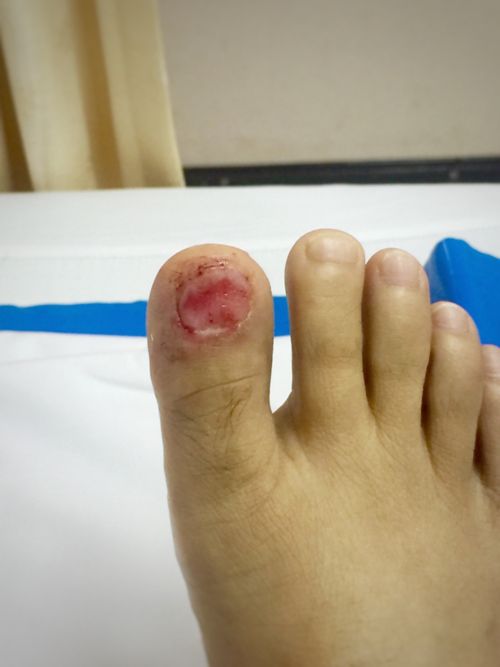Health care providers may remove your child’s toenail to treat significant, repeated problems such as:
- Ingrown toenail (the corner of the nail grows into the skin of the toe)
- Loose toenail
- Deformed toenail
- Infection underneath the toenail
- Inflamed soft tissue around the nail due to chemotherapy treatment (chemo toe)
The provider might remove the whole toenail or just the edges (nail borders). During the procedure, the health care provider will:
- Clean the toe to kill germs.
- Give your child an anesthetic to numb the toe.
- Put a band around the toe to reduce bleeding.
- Remove the nail or just the edges.
- Apply a solution to a specific area to keep the ingrown portion from growing back.
What to expect after toenail removal
After removal, your child may have:
- Pain and soreness
- Redness and swelling
- A blister on their toe that may drain (fluid comes out)
- Some remaining toenail that stays loose for awhile
Home care after toenail removal
On the day of toenail removal
After the procedure, the foot must stay dry. Your child must keep the bandages on. Have your child rest with the foot up as much as possible for 24 hours to reduce swelling.
You might notice some blood on the bandage on the day of the procedure. A small amount of blood is normal, but call your health care provider if you have questions.
Home care on the day after toenail removal
You must soak your child's toe the day after toenail removal (24 hours later). Follow these steps:
- Wash your hands with soap and water for 20 seconds and dry them. You can also rub an alcohol-based hand sanitizer on your hands and let them dry completely.
- Remove your child's bandage. You can gently apply warm water to soften any adhesive or other material that is sticking to the toe.
- Prepare a solution made of 2 teaspoons of Epsom salt in 2 quarts of warm water. Add this to a bowl or pan that is large enough to hold your child's foot. You can also use warm water without Epsom salt for soaking.
- Have your child soak their toe for 15 minutes.
- Allow the foot to completely dry or pat it gently with a piece of sterile gauze until dry.
Next, put on a new bandage. Follow these steps:
- Wash your hands with soap and water for 20 seconds and dry them. You can also rub on an alcohol-based hand sanitizer on your hands and let them dry completely.
- Apply a small, pea-sized amount of antibiotic ointment on a bandage as directed by your health care provider.
- Cover your child's toe with a bandage as directed by your health care provider.
- Apply a toe sock over your child's toe and the bandage. Loosely tape it to your child's foot. Your care team will show you how to do this. Do not tape on the sock so that it is too tight. Your child's toe will heal better if the sock is not tight.
- Check the wound daily for signs of infection, such as increased redness, swelling, pain, or warmth. Watch for drainage coming from the wound.
Repeat this home care until your child's next appointment . It is important to go back to the doctor to check the toe, even if everything looks fine. Your health care provider needs to check your child's foot to see if it is healing correctly.
Contact your child’s care team if you notice that your child has:
- More pain
- More redness, swelling, or warmth around the wound
- More fluid coming out of the wound, or pus that smells
- Fever
- Change in the color of the toe (pale, blue, black)
- Your child can not move the toe
Giving medicine after toenail removal
Your child’s health care provider may prescribe pain medicine and an antibiotic. Give medicine exactly as directed.
Make sure your child takes all the prescribed antibiotics even if they feel well before the antibiotic is gone. Taking it all will help keep your child from getting an infection.

